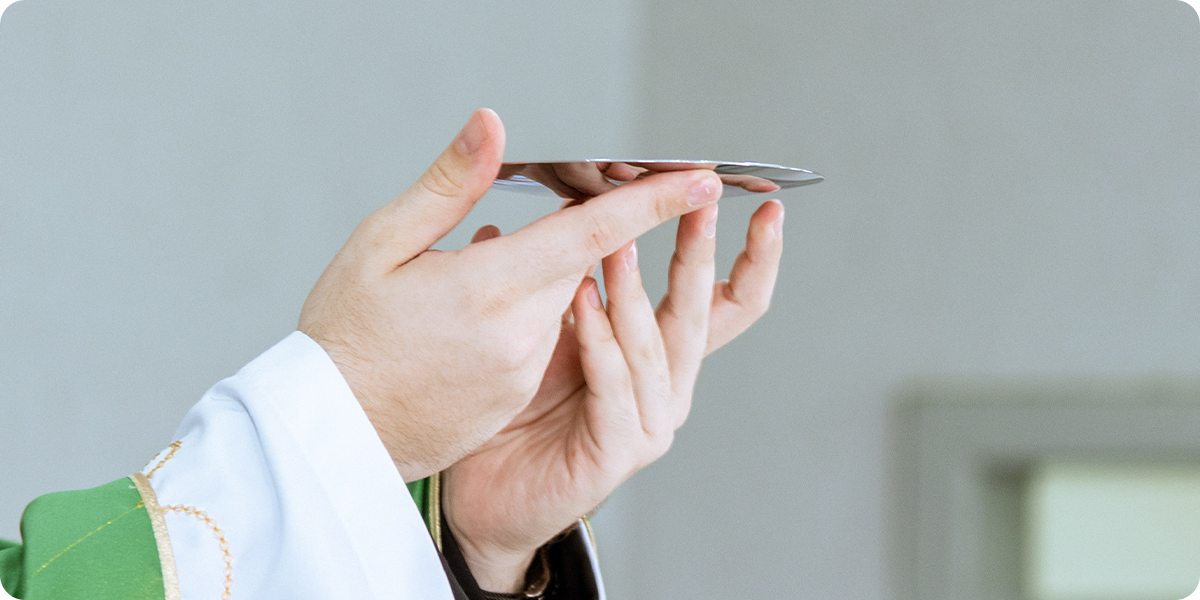

Continuing through the parts of the Eucharistic Prayer, this week we look at the Oblation, where the Church “offers the unblemished sacrificial Victim in the Holy Spirit to the Father… as well as our very selves” (GIRM, 79). We certainly have a lot to be excited about, especially Holy Communion, which is coming. Lest we lose focus and let our attention fade, the prayers that follow the Memorial Acclamation help us to recall the Mass as the one perfect sacrifice, as well as our participation in that sacrifice.

Perhaps you will recognize these words from Eucharistic Prayer I: “We, your servants and your holy people, offer to your glorious majesty from the gifts that you have given us, this pure victim, this holy victim, this spotless victim, the holy Bread of eternal life and the Chalice of everlasting salvation.” According to the Diocese of Peoria, “As we offer to God the gifts, we offer to Him ourselves—as Christ did, we offer Him our very lives. As we offer ourselves, we do so with the entire Church, here on earth and in heaven, and we ask that we, too, may share in their fellowship… Our praise and worship is always united with theirs, as the entire Church is present at every Mass” (“A Study of the Mass,” p. 16). As we hear in Eucharistic Prayer II, “Have mercy on us all, we pray, that with the Blessed Virgin Mary, Mother of God, with blessed Joseph, her Spouse, with the blessed Apostles, and all the Saints who have pleased you throughout the ages, we may merit to be coheirs to eternal life, and may praise and glorify you through your Son, Jesus Christ.”
This offering also reminds us: “We are not mere spectators; we are participants. Even though it is the priest who offers these prayers in the name of the community, all present at the Mass can offer their silent prayers with the priest. This is a most opportune time to ‘place our intentions on the paten’ and unite our offering with our Lord” (“A Study of the Mass,” p. 16). You may recall how previously we shared that Mother Teresa would imagine placing her heart and intentions on the paten on the altar. What Mother Teresa understood was that at this time of the Mass, all the eyes of heaven are focused on the altar before us. With all the saints and angels gathered around giving glory to God, they are praying with us and for us, making this time a great moment to be joined together with Christ.

The Eucharistic Prayers remind us that we not only offer our prayers in union with Jesus, the perfect offering, but we also offer ourselves to God: all that we are and all that we have to give, both to God and to others. This part of the Mass reminds us that we participate in the life of Jesus and that we should live out that participation every day. Charles Belmonte writes, “Following the footprints of Jesus, our life becomes a prolonged Mass. Here is a summary or program of life by which we can achieve this ideal:
So, instead of thinking about that nice meal that is going to follow the Mass, the fun day you have planned, or even what the next week will look like, why not thank God for the gift of Jesus present and remind ourselves to “live out the Mass”? In that mindset, maybe the meal or fun activity becomes a joyful offering. Maybe our work week or school schedule becomes a sacrificial offering. How different might our work be if, instead of putting in the time or getting our homework done, we are joined with Christ in making an offering to God?

1. Apply Charles Belmonte’s “program of life” to your own circumstances, and consider how you can witness to the joy of the Resurrection and Ascension in your daily life.
2. As you make your plans for the day or week, reflect on what follows immediately after your participation in Mass and how to bring the graces you have received into the rest of your day.